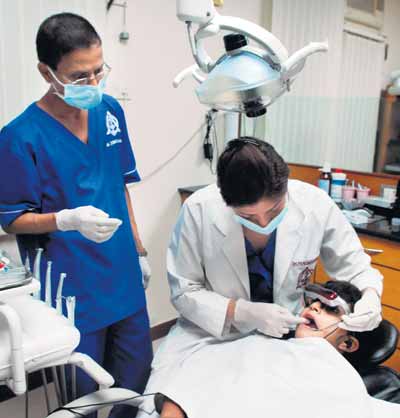A patient at Turners’ Speciality Dental Centre enjoys a movie on his glasses via the portable DVD player on his lap, even as Dr Ferzin Turner takes a look at his teeth. The Turners’ introduced these glasses in their clinic in 2008, and have been very happy with the results. ‘Nervous adults use these to help them relax, while kids absolutely love it,’says Turner. Pic/ Sayed Sameer Abedi
Date: 2011-01-19

By: Anjana Vaswani Date:2011-06-26 Place: Mumbai
Soon, nightmares of drill machines that visit you as your root canal procedure date nears, will be a thing of the past. If virtual reality therapy, already being used by city doctors in different forms, makes its way into mainstream surgical procedures, you might soon be shooting snowballs in a video game without even noticing that your bandages are being changed

A patient at Turners’ Speciality Dental Centre enjoys a movie on his glasses via the portable DVD player on his lap, even as Dr Ferzin Turner takes a look at his teeth. The Turners’ introduced these glasses in their clinic in 2008, and have been very happy with the results. ‘Nervous adults use these to help them relax, while kids absolutely love it,’says Turner. Pic/ Sayed Sameer Abedi
At DR Turners’ Speciality Dental Centre in Tardeo’s Gamadia Parsi Colony, a pair of glasses that look suspiciously similar to the ones you wear for a screening of a 3D film catches your attention. Except that this futuristic pair is worn by fidgety patients during treatment, to distract them from pain and discomfort. So, while Dr Ferzin Turner, who runs a combined practice here with her brother Ashdin and father Porus, fixes cavities and pulls out teeth, happy children sail through the pain thanks to these glasses that are connected to a portable DVD player and accompanied by headphones.
Ferzin’s 8-year-old son, Zane, slides onto the recliner and slips on the funky-looking pair to demonstrate the use of his favourite gizmo. ‘The glasses are connected to a portable DVD player, so you can watch any movie you like and ear-phones cut out the sound of the drill that people are frightened by,’ her husband Danesh Vazifdar, who runs a dental technology laboratory across the hallway explains. Ferzin adds, ‘As the glasses prevent you from seeing what’s going on and cut off the procedure’s sounds, we find they’re very effective to help people relax. Often, patients completely forget that they’re getting a dental treatment done.’
The Turners’ philosophy is in line with the research conducted by Hunter Hoffman, director, Virtual Reality Research Centre, University of Washington, and his colleagues. Called Virtual Reality Therapy (VRT), the idea of using video games to distract burn victims during medical procedures is now a reality at many places worldwide, including Randolph Hearst Burn Centre in New York, Copenhagen Burn Centre and Martini Ziekenhuis Groningen in Holland, among others.
Over email, Hoffman, who created SnowWorld, a virtual reality world, confirms, ‘Directing a patient’s attention onto something other than wound care can help reduce his or her suffering by as much as 35 to 50 per cent.’
Think about that the next time you have to get an injection.
An escape from suffering
Hoffman has no doubts about the effectiveness of virtual reality therapy. Explaining his research on ‘Immersive Virtual Reality Pain Distraction,’ he says, ‘Pain has a strong psychological component. This means that psychological interventions can be used, in addition to strong pain medications, to help reduce the pain levels experienced during wound care procedures.’
That explains why it would work with burn patients, who ‘cannot take their eyes off their wounds during routine treatments,’ says Hoffman. With no side effects and a one-time-cost, burn victims, Post Traumatic Stress Disorder (PTSD) sufferers and those whose lives are crippled by phobias may soon have access to these simple, even enjoyable, means of treatment.
‘We have also conducted another pilot study to see how virtual reality distraction can reduce the anxiety of patients with claustrophobia,’ Hoffman tells us.
Like him, Ferzin and Danesh are very enthusiastic about the research that has led to the recent use of VR therapy, because, as Ferzin says, ‘Typically a dental procedure could take up to 45 minutes, so if a game occupies our patients’ minds and makes their visits here more comfortable, we’d be all for trying it out.’
‘We were in Minneapolis for an American Dental Association conference about three years ago when we first came across these glasses,’ recalls Ferzin. They then purchased an additional pair (they cost under Rs 20,000) to keep their kids, Jeanine (6) and Zane occupied during their travels.
Today, anxious children and their parents flock to the centre for the promise of a less discomfiting dental procedure.
Addictive, difficult in practice
Not everyone is sold on the concept, though. Dr Bijoy Methil, consultant Cosmetic and Plastic Surgeon at Jaslok and Saifee Hospitals, cannot imagine how anything can be used to distract burn victims from the agony of their treatments. ‘Cleaning and bandaging is extremely painful because the patient’s skin is sensitive. It would be impossible to work without the use of anaesthetics or analgesics,’ he asserts, when we mention the use of virtual reality therapy to alleviate the pain of burn-victims overseas.
‘Besides, with intravenous lines in their hands, how would patients even manage to play a game?’
For Professor RSS Mani, Human Resource Management Educator and Career Mentor, it’s the addictive nature of video games, similar to the after-effects of alcohol, that makes him wary of VR therapy. ‘Precisely because of their distractive nature, video games are more destructive than constructive. If a child takes a video game break while studying, for instance, it’s practically impossible for him or her to regain focus after such a break.’
Although he lauds the research and believes that the ‘restrictive use of such games can be extremely enabling,’ he cautions, ‘Virtual reality games can draw children away from real games. The loss of exercise and social interaction is extremely detrimental to a child’s well being. So, the use of such games must be restricted.’
Less histrionics, perhaps
Varkha Chulani, clinical psychologist, Lilavati Hospital, believes that virtual reality therapy may work by creating ‘powerful distractions’ to shift focus from emotional pain that comes from ‘discomfort created by the mind.’
She explains that the device would be particularly effective with histrionic personality types, ‘in the case of people who tend to exaggerate a difficult situation. Pain management becomes an important facet of their lives and we typically try to change their attitude towards pain through cognitive re-structuring techniques.’
So, is it possible to use VR therapy to target areas of the brain and thereby treat psychological issues? Chulani doesn’t think so. ‘It’s difficult to earmark the areas of the brain that cause psychological disorders, so such a scenario would be unrealistic.’
But Hoffman disagrees. ‘When treating psychological disorders, virtual reality can be used to help patients confront the object, situation, or memories they are currently avoiding and to gradually help them become more comfortable in the presence of the thing they fear.’
Fewer pills
Dr Dwarkadas Baheti, professor and head of the Department of Anaesthesia and Pain Management, Bombay Hospital Institute of Medical Sciences and Consultant Pain Physician of Lilavati, Shushrusha and Raheja Hospitals, is in agreement with Hoffman. ‘Distraction is a useful tool especially in the case of acute pain, as experienced by burn victims. It has also been seen to relieve depression,’ he says.
Cosmetic dermatologist and laser surgeon, Dr Apratim Goel is excited by the possibilities offered by VR therapy.
‘In the treatment of extremely painful conditions like Pemphigus, where blisters cover the body or genital Herpes where a change of dressing can be excruciating, VR games could be very helpful, because the sensations of itch and pain occupy the same pathway in the brain. As it would assist in providing pain-relief without causing side-effects, we would certainly opt for such a device when it becomes available here.’
And with Hoffman adding that the University of Washington along with him and his colleague Dave Patterson, are happy to share the SnowWorld software to clinics and hospitals in India if they’re ready to buy the VR helmets/goggles, it just might happen sooner than you think.
More breakthroughs in pain relief
- American company Renewal Technologies announced the issue of its ‘breakthrough pain-relief’ device in September last year. Dubbed, Laser Touch One, the FDA-approved design doesn’t require a prescription. It works by combining low-level-laser and micro-current electrical stimulation to promote the body’s natural healing process at a cellular level.
- Using a remote control worn like a wristwatch, the ReWalk received FDA approval in January. The $50,000 device that Amit Goffer, founder of Argo Medical Technologies, a quadriplegic himself, invented, is a set of mechanical legs attached to a backpack battery that allows paralysed people to walk again.
- Earlier this year, Dr J rg Gerlach and scientists at the University of Pittsburgh announced the development of a revolutionary ‘skin-spray-gun’ that could heal severe burns within days. The gun works by firing stem cells on to damaged skin, so where ordinarily the procedure would require sheets of skin to be grown in a laboratory over a month, stem cells are harvested from a patch of healthy skin, put into a solution and sprayed back on to the affected area in a process that only takes 90 minutes.
